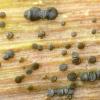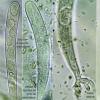
10-09-2025 17:18
 Blasco Rafael
Blasco Rafael
Hola, encontre este estiercol de vaca estos apotec

02-09-2025 11:34
Thomas Læssøehttps://svampe.databasen.org/observations/10527903

10-09-2025 23:53
 Marcel Heyligen
Marcel Heyligen
Found on Robinia pseudoacasia together with Diapor

03-09-2025 21:59
Philippe PELLICIERLa Léchère, Col de la Madeleine, alt 1970m, au s

07-09-2025 11:34
 Zuzana Sochorová (Egertová)
Zuzana Sochorová (Egertová)
Hello,I have identified this fungus as Hymenoscyph

05-09-2025 09:32
 Nicolas VAN VOOREN
Nicolas VAN VOOREN
Bonjour, hi everyone,Do you know where the fungari
Patellaria atrata ou Claussenomyces atrovirens ??
Bernard CLESSE,
09-02-2020 20:39
 Sur tronc mort et décortiqué de chêne en ambiance humide.
Sur tronc mort et décortiqué de chêne en ambiance humide. Je pensais à Patellaria atrata mais Raul Tena Lahoz propose Claussenomyces atrovirens, que je ne connaissais pas.
Pourriez-vous donner votre avis et me dire quelle est la différence entre ces deux taxons ?
Grand merci d'avance !
Bernard
Hans-Otto Baral,
09-02-2020 20:45

Re : Patellaria atrata ou Claussenomyces atrovirens ??
Thsi difference is huge: Patellaria forms septate spores with a high oil content that are ejected as such. Clauss. atrovirens and related species forms septate spores with low oil content (see your photo) and these spores germinate inside the immature asci to form numerous minute conidia. The conidia aggregate in balls, see your photo. The balls are ejected. Some conidia are floating in your preparation. they are rod-shaped and also the possible absence of longisepta in the ascospores (only cross-septa) point against atrovirens.
A difficult genus with some undescribed species. Look in my folde and compare e.g. C. munathinus and C. xylophilus.
The genus stands in the Phacidiales, Tympanidaceae.
Raúl Tena Lahoz,
09-02-2020 20:59

Re : Patellaria atrata ou Claussenomyces atrovirens ??
In fact, my anwser to Bernard was to draw his attention to Claussenomyces... I didn't try to get deeper in this difficult genus.
Cheers,
Raúl
Cheers,
Raúl
Bernard CLESSE,
09-02-2020 21:22

Re : Patellaria atrata ou Claussenomyces atrovirens ??
Great thanks Peter, Raul and Zotto !!
I learned a lot of new things again! What an extraordinary forum!
And sorry to have generated two discussions instead of one (a handling error!)
Bernard




